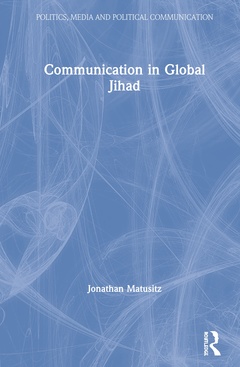Communication in Global Jihad Politics, Media and Political Communication Series
Auteur : Matusitz Jonathan

This book conceptually examines the role of communication in global jihad from multiple perspectives. The main premise is that communication is so vital to the global jihadist movement today that jihadists will use any communicative tool, tactic, or approach to impact or transform people and the public at large. The author explores how and why the benefits of communication are a huge boon to jihadist operations, with jihadists communicating their ideological programs to develop a strong base for undertaking terrorist violence. The use of various information and communication systems and platforms by jihadists exemplifies the most recent progress in the relationship between terrorism, media, and the new information environment.
For jihadist organizations like ISIS and Al-Qaeda, recruiting new volunteers for the Caliphate who are willing to sacrifice their lives for the cause is a top priority. Based on various conceptual analyses, case studies, and theoretical applications, this book explores the communicative tools, tactics, and approaches used for this recruitment, including narratives, propaganda, mainstream media, social media, new information and communication technologies, the jihadisphere, visual imagery, media framing, globalization, financing networks, crime?jihad nexuses, group communication, radicalization, social movements, fatwas, martyrdom videos, pop-jihad, and jihadist nasheeds.
This book will be of great interest to students and scholars of communication studies, political science, terrorism and international security, Islamic studies, and cultural studies.
1. Introduction 2. Defining Terrorism 3. Defining Jihad 4. The Globalization of Jihad 5. Global Jihadist Networks 6. The Mass Media 7. The Narrative 8. The Fatwa 9. Islamic Revival 10. The Jihadisphere 11. Jihad through Popular Culture 12. Conclusions and Solutions
Jonathan Matusitz is Associate Professor in the Nicholson School of Communication and Media at the University of Central Florida, USA. His research focuses on the role of communication in terrorism, symbolism in terrorism, and the globalization of culture and new media. Previous titles include Global Jihad in Muslim and Non-Muslim Contexts (2020), Online Jihadist Magazines to Promote the Caliphate: Communicative Perspectives (2019), Symbolism in Terrorism: Motivation, Communication, and Behavior (2015), and Terrorism & Communication: A Critical Introduction (2013).
Date de parution : 11-2020
15.6x23.4 cm
Date de parution : 11-2020
15.6x23.4 cm
Disponible chez l'éditeur (délai d'approvisionnement : 14 jours).
Prix indicatif 37,68 €
Ajouter au panierThème de Communication in Global Jihad :
Mots-clés :
Global Jihad; Communication; Muslim World; Global; Jihadist Organizations; Jihad; GJM; Caliphate; Jihadist Groups; Media; Young Men; Technology; Martyrdom Videos; Propaganda; Jihadist Networks; Terrorism; ISIS Leader; Terrorist; Foreign Fighters; Politics; Jihadist Narrative; Political; Anwar Al Awlaki; Islam; Abdullah Azzam; Muslim; ISIS; Radicalise; Social Media Effects; Radicalize; Dirty Kuffar; Jihadist Videos; Martyr; Lone Wolf Terrorism; Network; Virtual Ummah; Al–Qaeda; Kitab Al Jihad; Fatwa; Bin Laden’s Fatwas; Communication systems; Ali Ibn Tahir Al Sulami; Global jihadist movement; Jihadist Foreign Fighters; Terrorist violence; Salafist Jihadists; Ideological programs; Fatwa Shopping
